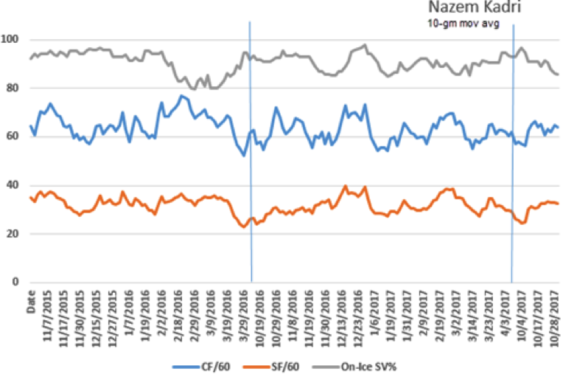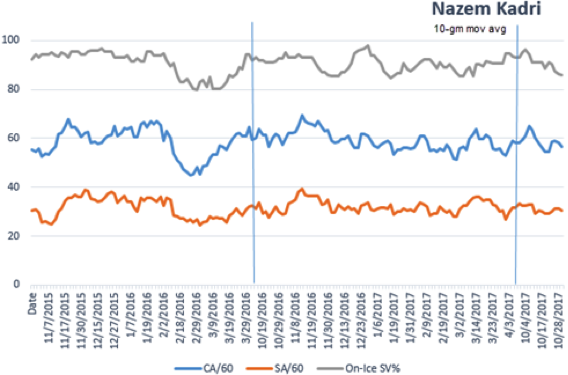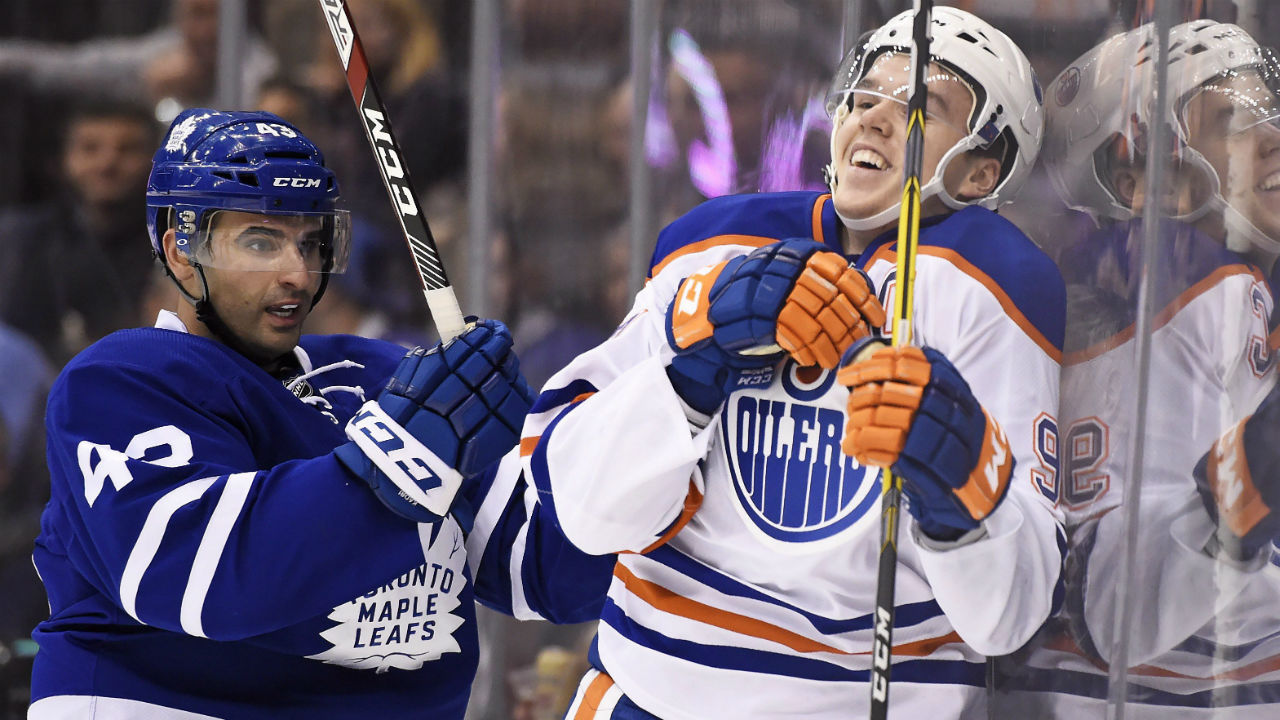Nazem Kadri has become quite the hockey player. He exhibits an excellent mix of physical persistence and belligerence that makes him difficult to play against. A force along the boards, he also has the escapability to exploit seams to create offense.
And then there’s the skilled side: Kadri is a fine shooter and playmaker. Add all the components together, and he’s one of the better lower-tier first-line centers in the league (currently playing behind an elite first line center in Auston Matthews).
During his breakout offensively during the 2016-17 campaign, he was lauded frequently for the improvements in his defensive game.
An ambitious analytics deep dive can prove fruitful in a discussion about the rapidly-changing definition of ‘defense’. For me, defense is orchestrating methods of getting the puck back. My three-pronged approach compartmentalizes each stage:
- Engaging the opposition
- Supporting with numbers to get the puck back
- Transitioning to offense
In the offensive zone, attacking teams without the puck are actively playing defense and an active forecheck produces defensive results if it successfully gets the puck back. Upon retrieval, a team has transitioned to offense. Without a shot on goal, or any threat of allowing an attempt, the puck retrieval is a great defensive play that is not captured in any current metric. The way defense — or defensive impact — is measured contains flaws that stem from these scenarios.
If defense is all about puck retrievals, defensive impact should, therefore, be measured more from the changes in offensive contributions – or at least shot attempt metrics or increases in expected goals.
With the way defense is being redefined, contemporary analysis focuses on the ‘against’ elements to look for improvements in defensive games; the theory being that a lower shot attempt against rate equals better defensively. There’s partial truth to that statement, but if we’re saying that defense is about getting the puck back, strong defensive play should have leading indicators in the offensive elements.
Neutral zone puck battles produce the same type of transition by retrieving the puck from the opposition without any threat of a shot on goal – removing the event from any tangible measure. In the defensive zone, a shot from a very long distance in a low-percentage part of the ice can be an effective starting point to transition if the turnaround can beat the forecheck and head the other way.
Nazem Kadri and the Selke
Nazem Kadri was touted as a legitimate Selke candidate in 2016-17 in some corners, but was he really worthy? He finished with a few votes and established himself as reliable and responsible on the ice. These traits will make him more valuable offensively.
Selke Voting pic.twitter.com/ApJQaUAk6a
— Elliotte Friedman (@FriedgeHNIC) June 22, 2017
Players are often-times lambasted for highly-visible mistakes by fans and media who gloss over exceptional play to focus primarily on the errors. I sometimes feel the opposite is true, as well. Images of random exceptional backchecking efforts and good board work (inherent in his game already) amplified the legend of ‘Kadri for Selke’, while most of the same type of ethic and positioning hadn’t really changed.
Kadri was an excellent fit structurally for Mike Babcock in his inaugural coaching season in 2015-16, but he couldn’t find the scoring touch he later discovered in 2016-17. He underperformed his expected goals in 2015-16 at 5v5 on an individual basis, scoring only nine goals while firing a low shooting percentage.
Improvement in his offensive numbers the following season was reflective of a developing, good defensive game as well as an improved surrounding cast that helped to get the puck back and capitalize in the offensive zone. It’s not like Kadri improved leaps and bounds defensively to warrant Selke chatter; rather, an injection of talent and his fit with coaching expectations produced exceptional results.
| Player | Season | G | A | P | P1 | P/60 | P1/60 | ixGF | ixGF/60 | iSh% |
|---|---|---|---|---|---|---|---|---|---|---|
| NAZEM.KADRI | 2017-2018 | 4 | 4 | 8 | 6 | 2.9 | 2.18 | 1.87 | 0.68 | 18.18 |
| NAZEM.KADRI | 2016-2017 | 16 | 22 | 38 | 28 | 2.05 | 1.51 | 16.76 | 0.9 | 8.7 |
| NAZEM.KADRI | 2015-2016 | 9 | 11 | 20 | 18 | 1.1 | 0.99 | 16.08 | 0.88 | 4.55 |
It’s interesting to note that Kadri is off of his individual 5v5 shot attempt pace this season. He’s on track to fire about 252 individual shot attempts, fewer than the 300-plus attempts over the past two seasons. His individual shot attempts per 60 (iCF/60) are down as well this season. He’s scored four goals at 5v5 and is rocking an 18.18% shooting percentage.
| Player | Season | xGF | xGA | xGF% | iCF | iCF/60 | GF | GA |
|---|---|---|---|---|---|---|---|---|
| NAZEM.KADRI | 2017-2018 | 7.51 | 6.54 | 53.45 | 40 | 14.5 | 11 | 10 |
| NAZEM.KADRI | 2016-2017 | 51.21 | 45.48 | 52.96 | 329 | 17.76 | 49 | 52 |
| NAZEM.KADRI | 2015-2016 | 42.22 | 43.2 | 49.43 | 341 | 18.74 | 33 | 50 |
Plotting out the per-60 rates and on-ice save percentages over the previous two seasons and 2017-18, there’s nothing that jumps out to indicate any substantial defensive improvement.

Looking at the shot attempts against, the dip towards the end of the 2015-16 season featured terrible goaltending and high on-ice opposition shooting percentages. Goaltending save percentage took a dip and affected the rate of shot attempts from the opposition since they were scoring so often.

Coach’s Influence
Mike Babcock explained some of how the Selke chatter may have propagated last February. This exchange was notable.
(Emphasis is mine because it exemplifies the improved offensive production as a result of better defense – i.e. puck retrieval.)
Babcock: Well, I think Naz is just starting his journey. He’s way better than he’s playing. He can be way better. He’s going to start dominating the faceoff circle, which is important for him. He’ll be better in the faceoff circle. He’ll continue to get better without the puck and in doing so will end up scoring more. He’s a kid, to me, who took a huge step this summer with his training. He has to take another step again this summer with his training. He’s got a lot of growth potential. I’m impressed with him because he’s a bit nasty. He’s competitive at game time and learning to work harder every day. He’s becoming a better pro and he’s a big part of our team.
Is he legit in the Selke conversation in your estimation, Mike?
Babcock: This is what I’d tell you. When that first got talked about, I said to him, “do you really want to win that trophy?” He said, “Absolutely, one day I’d like to win that trophy.” I said, “then we’ve got lots of work to do.” But he wants to win it and I’m going to do everything I can to help him.
Did he bring up the Selke or did you?
Babcock: I don’t know who brought it up. Someone might have been busting his chops, you know what I mean? One of the boys. I happened to be in ear shot, so I grabbed him.
I think this is a situation where a specific play often presented in a .gif, a backcheck, or something distinctly discernable as a solid defensive play gets extrapolated to fuel the narrative about improved defensive play enough to be considered a Selke candidate.
Someone on the team was giving him the gears by teasing him about the Selke conversation when Babcock stepped in to address the commitment to achieve that lofty height. Selke nominees don’t flounder under pressure like this one-off sequence of horrible turnovers.
I
The propensity to elevate singular defensive plays into otherworldly praise has even started this season with phenom Auston Matthews. Selke chatter has somewhat dwindled with Kadri, while some of Matthews’ individual backchecking efforts have been captured in gifs online. Now, while there’s merit in the overall defensive game, the mention of Auston Matthews as a future Selke candidate has appeared.
“I’m a backchecker, yes I am…” pic.twitter.com/iFZHcqDNbk
— Uffe Bodin (@UffeBodin) October 24, 2017
The Selke, or best defensive forward, is a very misunderstood award. Those voting on the candidates often don’t really recognize the proper defensive positioning and excellence required. Most also discount the defensive plays in every zone. Defense isn’t just being committed to backchecks or hustles in backside pressure; it’s about fitting into the play to get the puck back, in every zone, in every situation.
The concept of defensive capability is changing rapidly, with analytics and system analysis presenting the dichotomy of playing a ‘prevent’ style versus a more aggressive approach. The way defense is measured should be changed, too. (Someone with better math and analytics skills than me can likely make a better case for offensive measures being incorporated into defensive presence.)
Nazem Kadri’s ‘Selke’ play isn’t as prevalent this season. Why? Perhaps because it was illusory in the first place.


































